

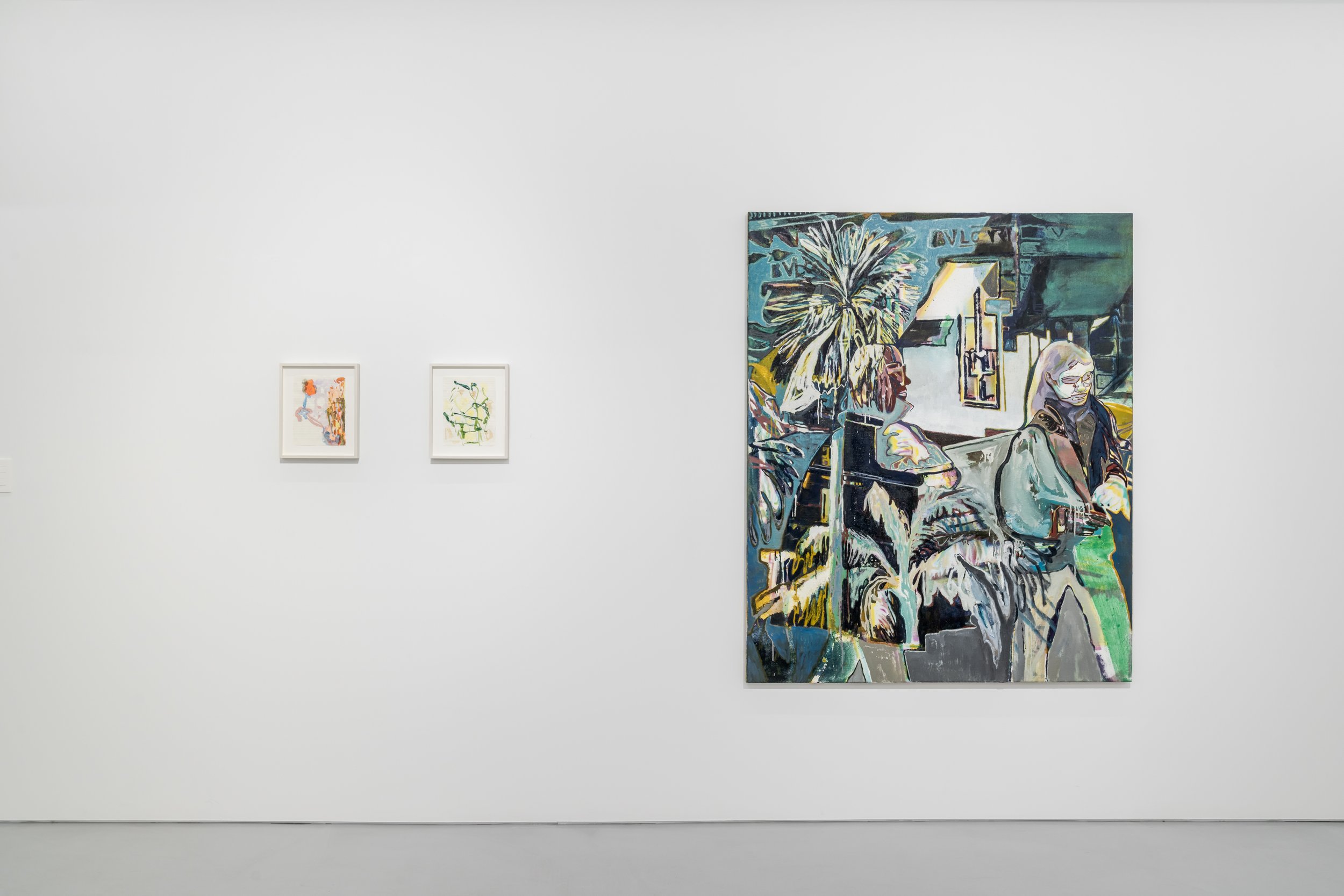


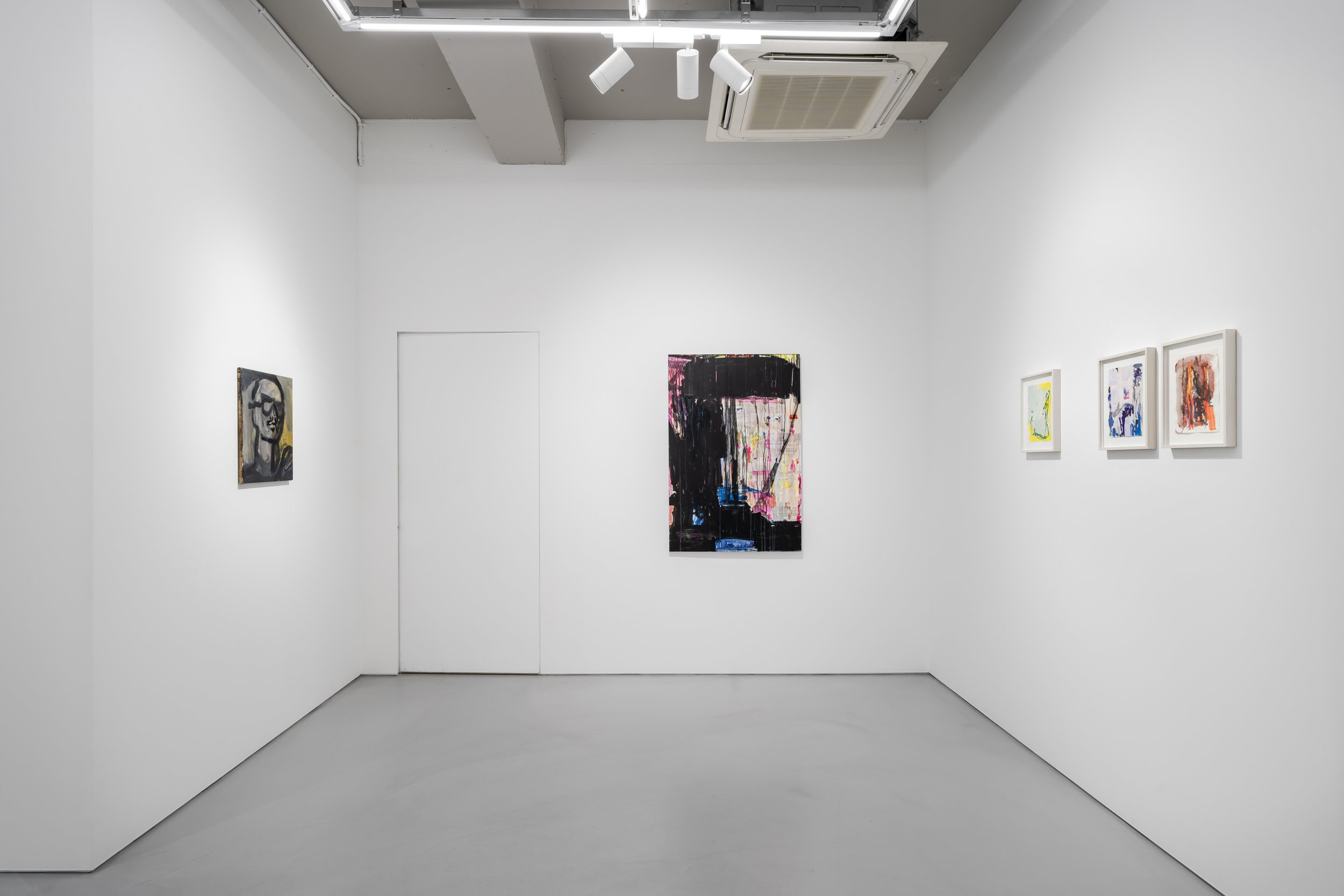

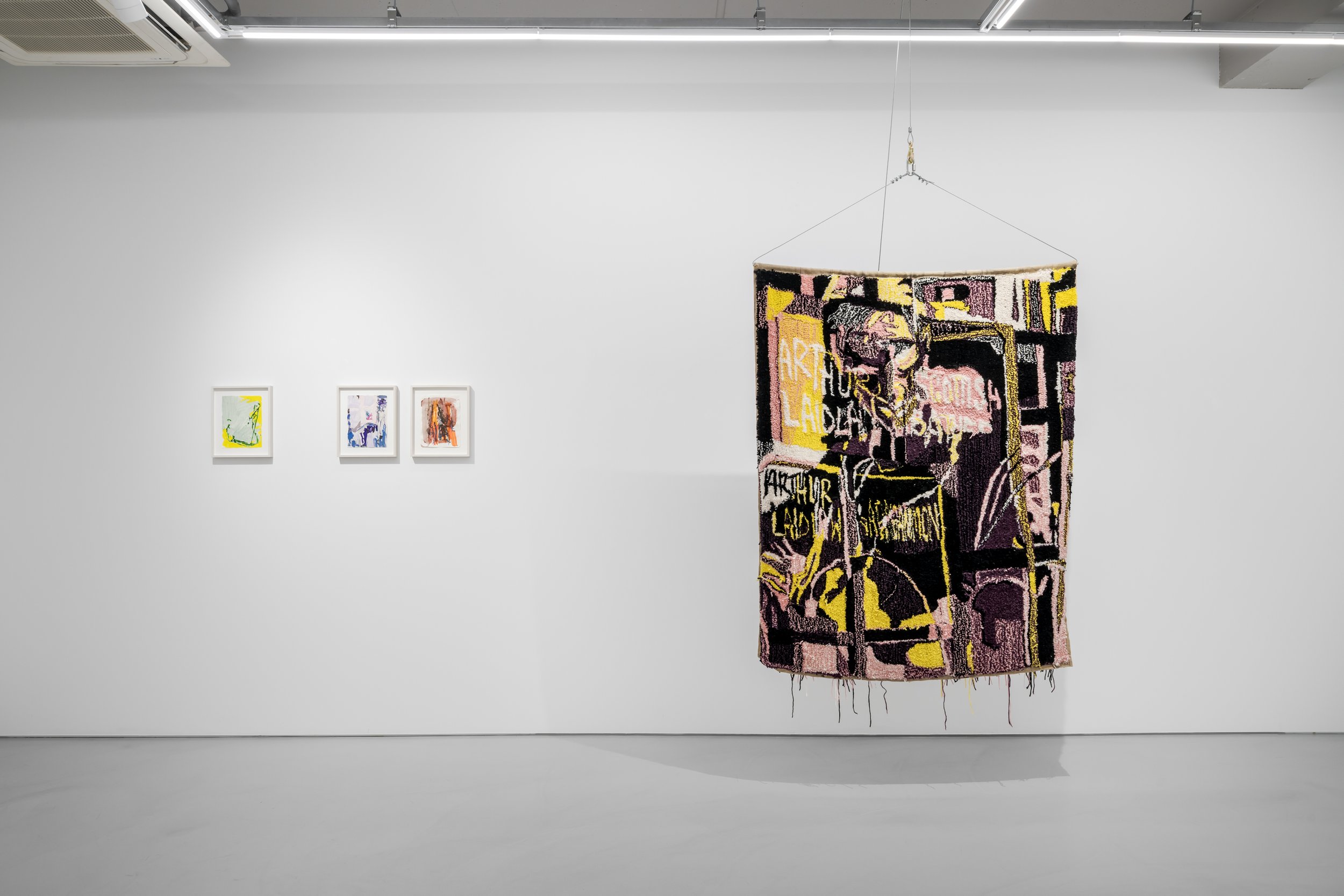

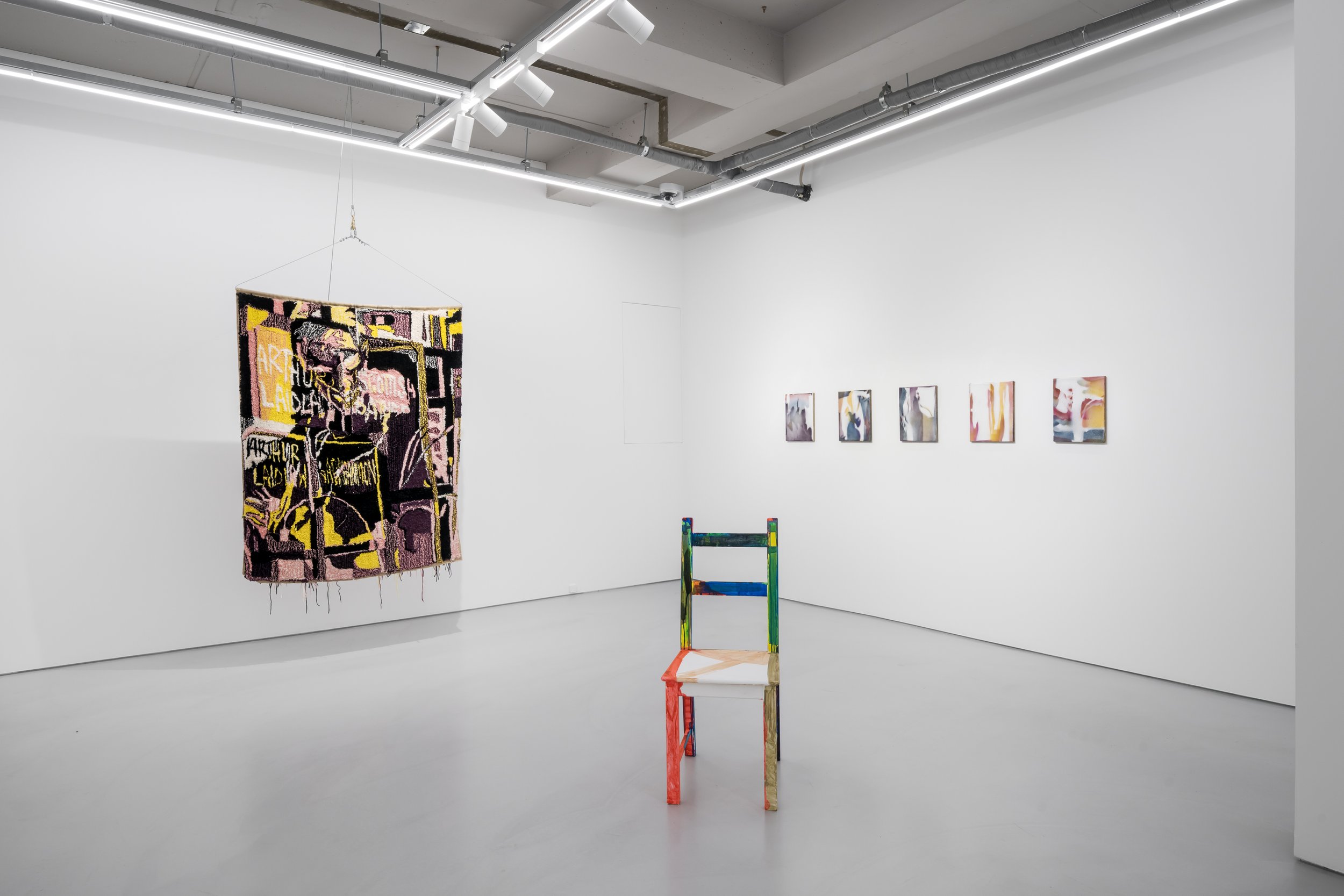
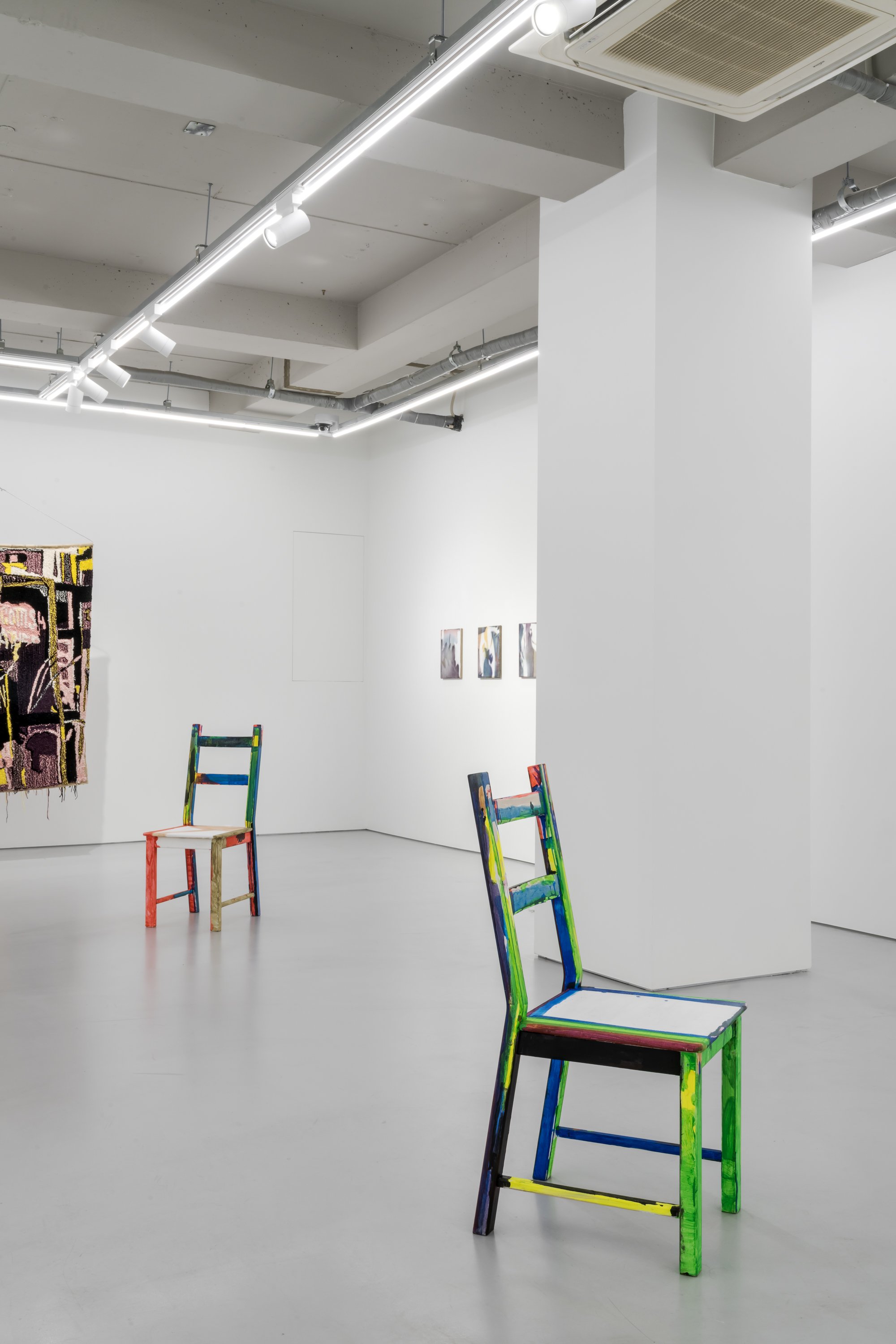

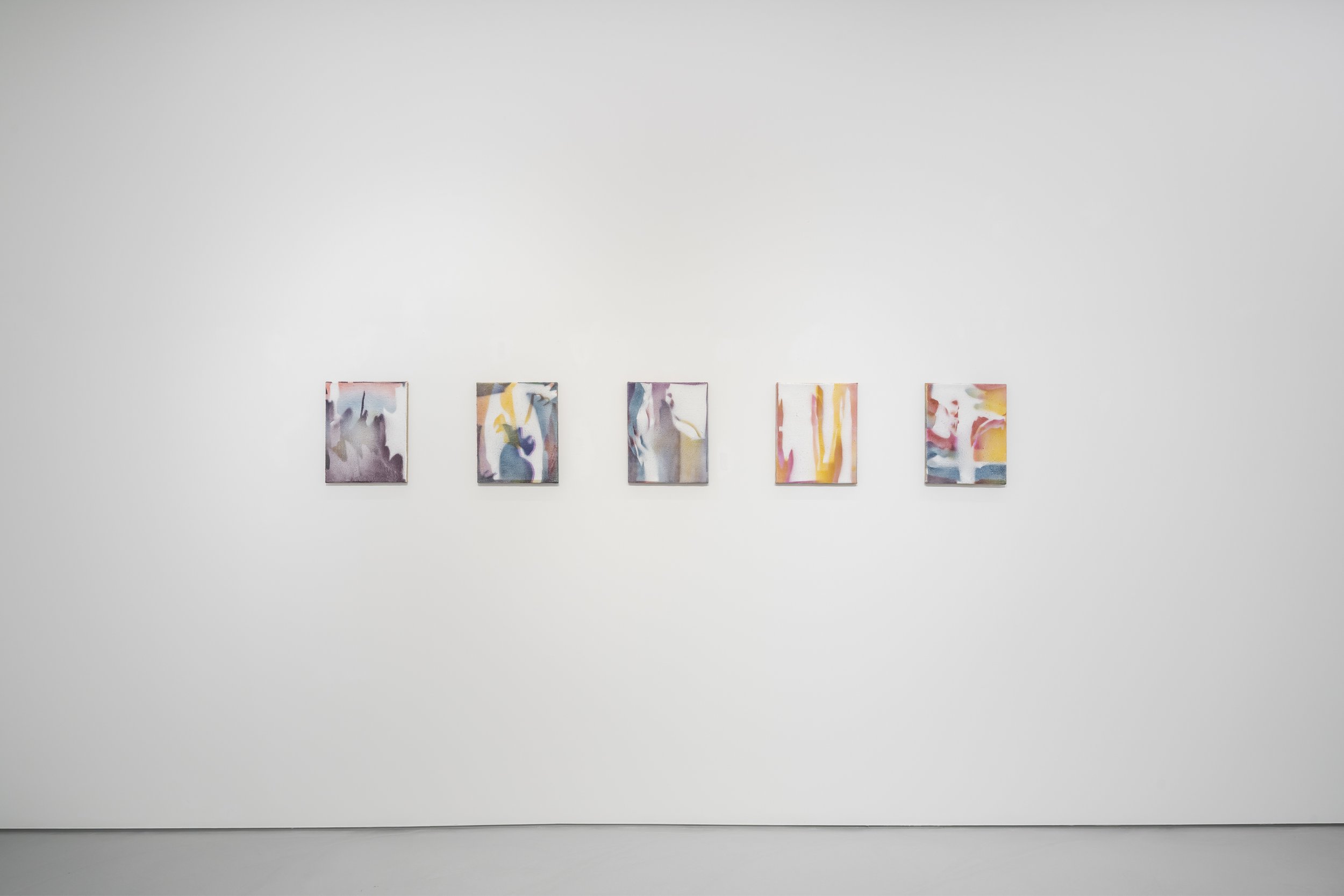
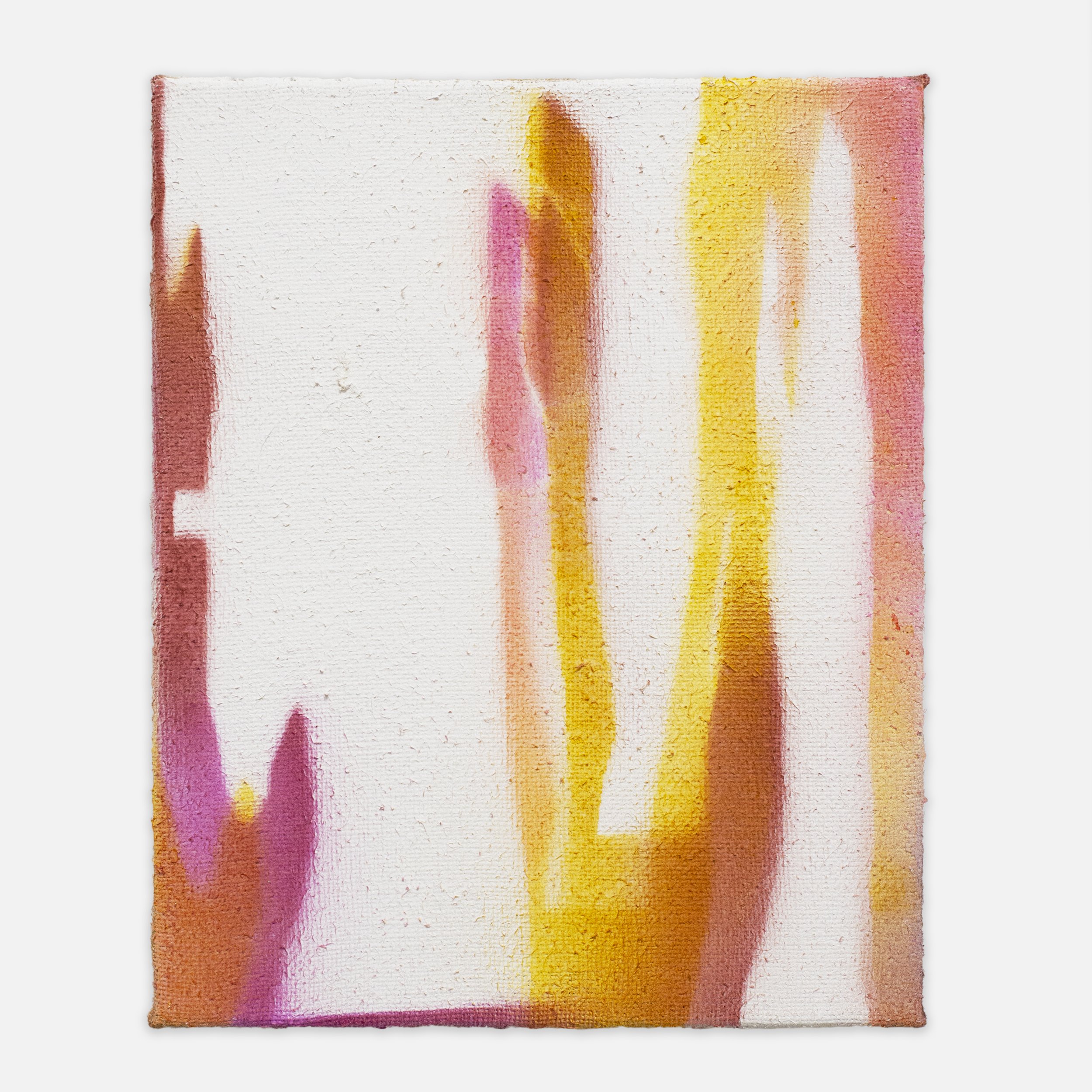
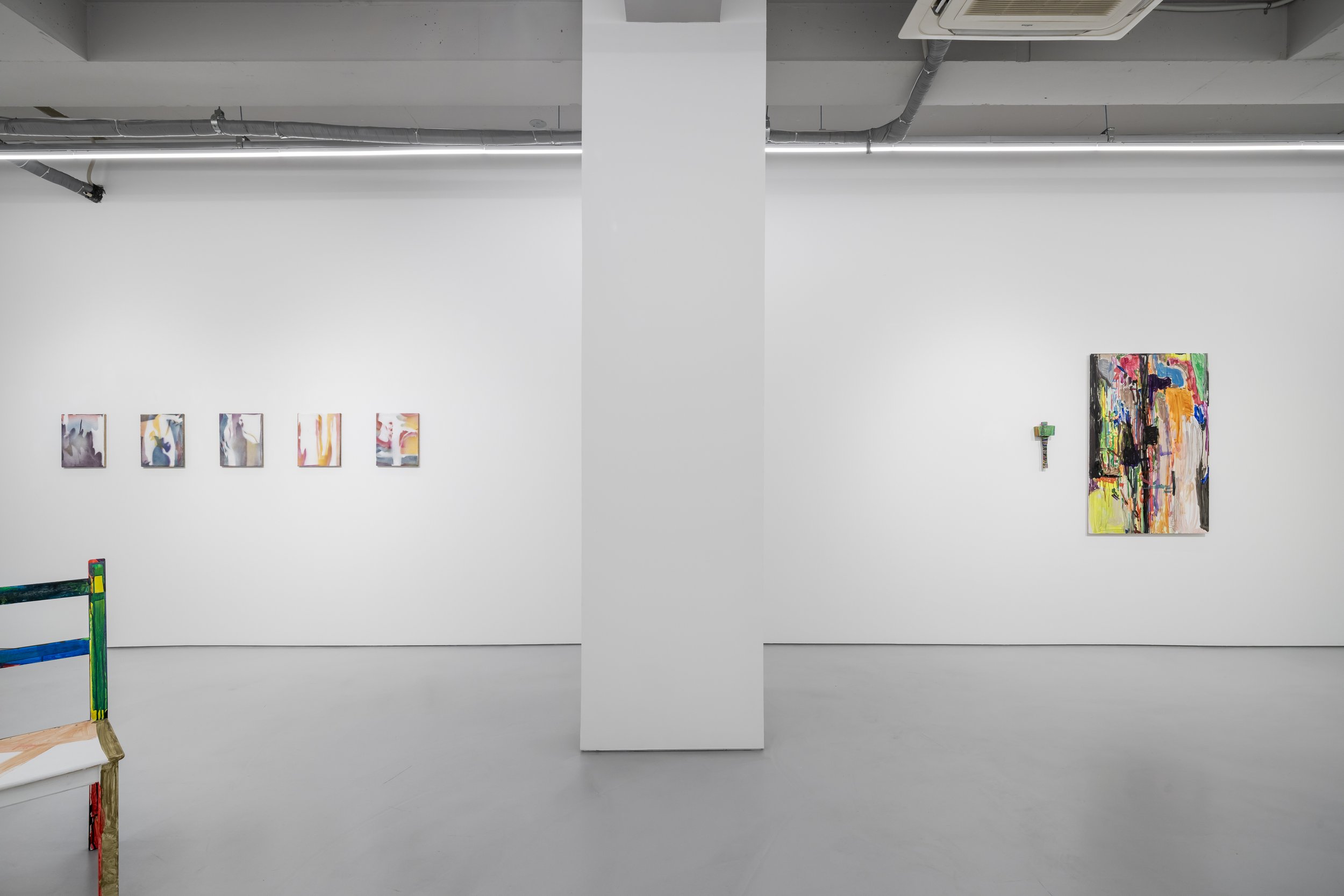

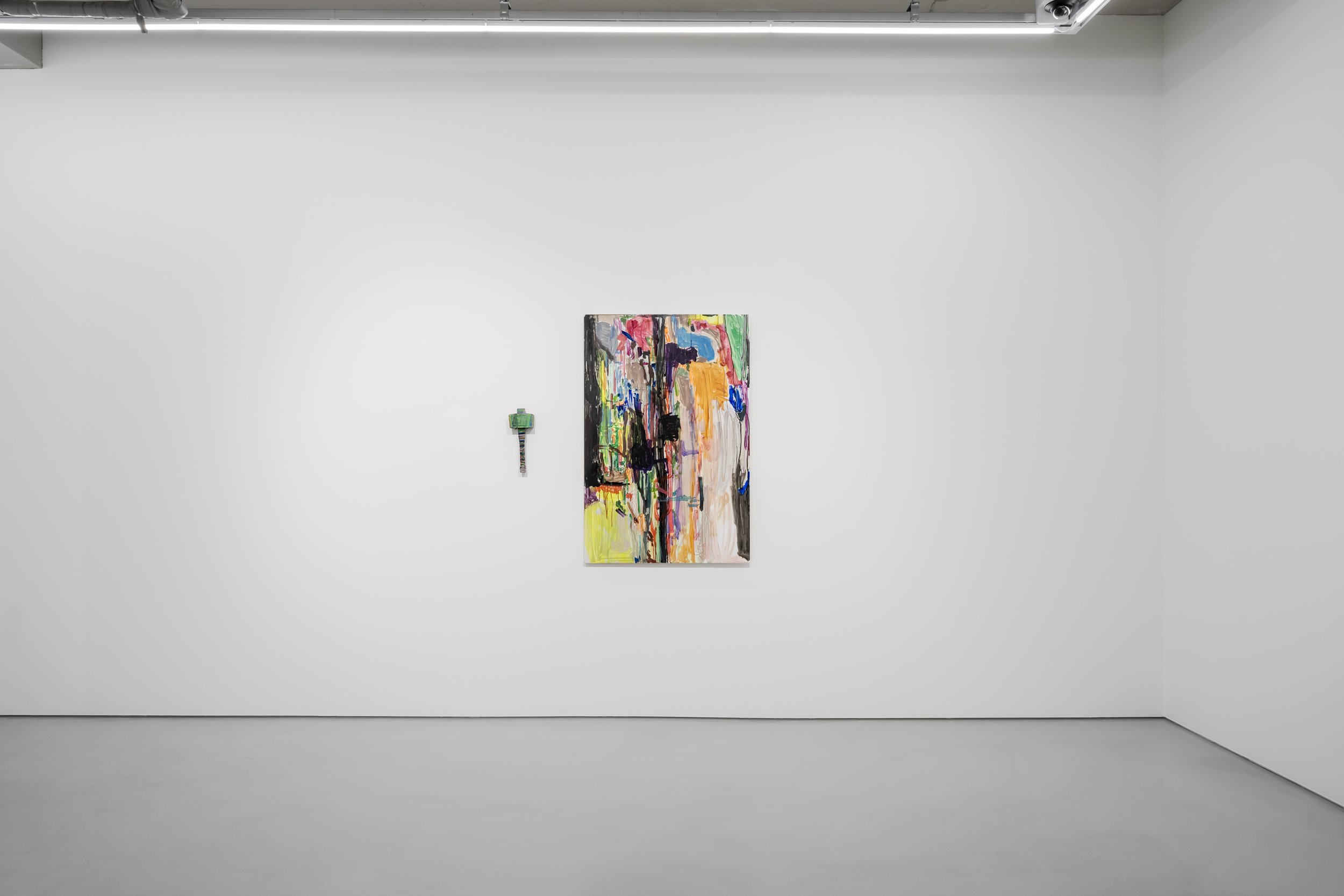
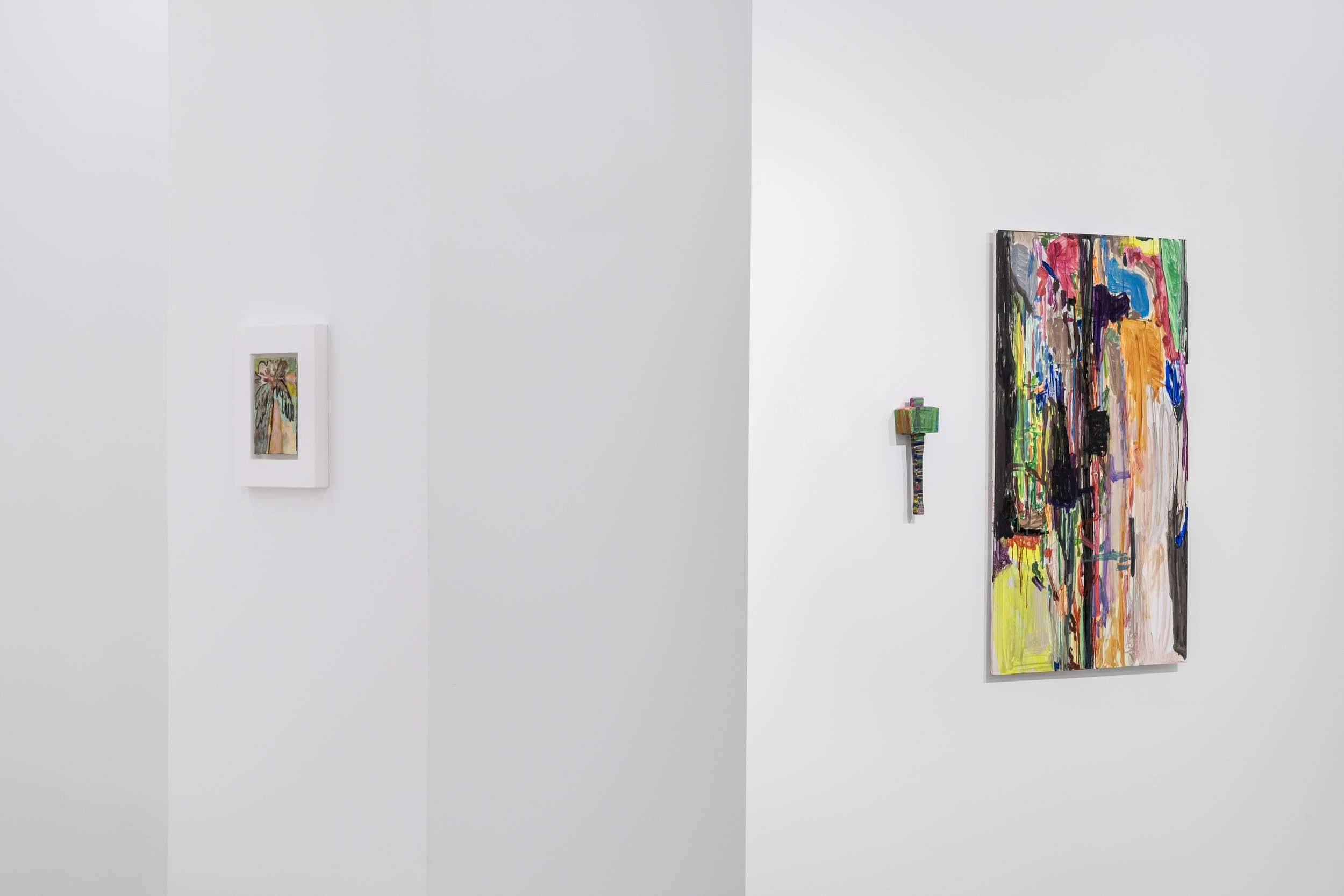
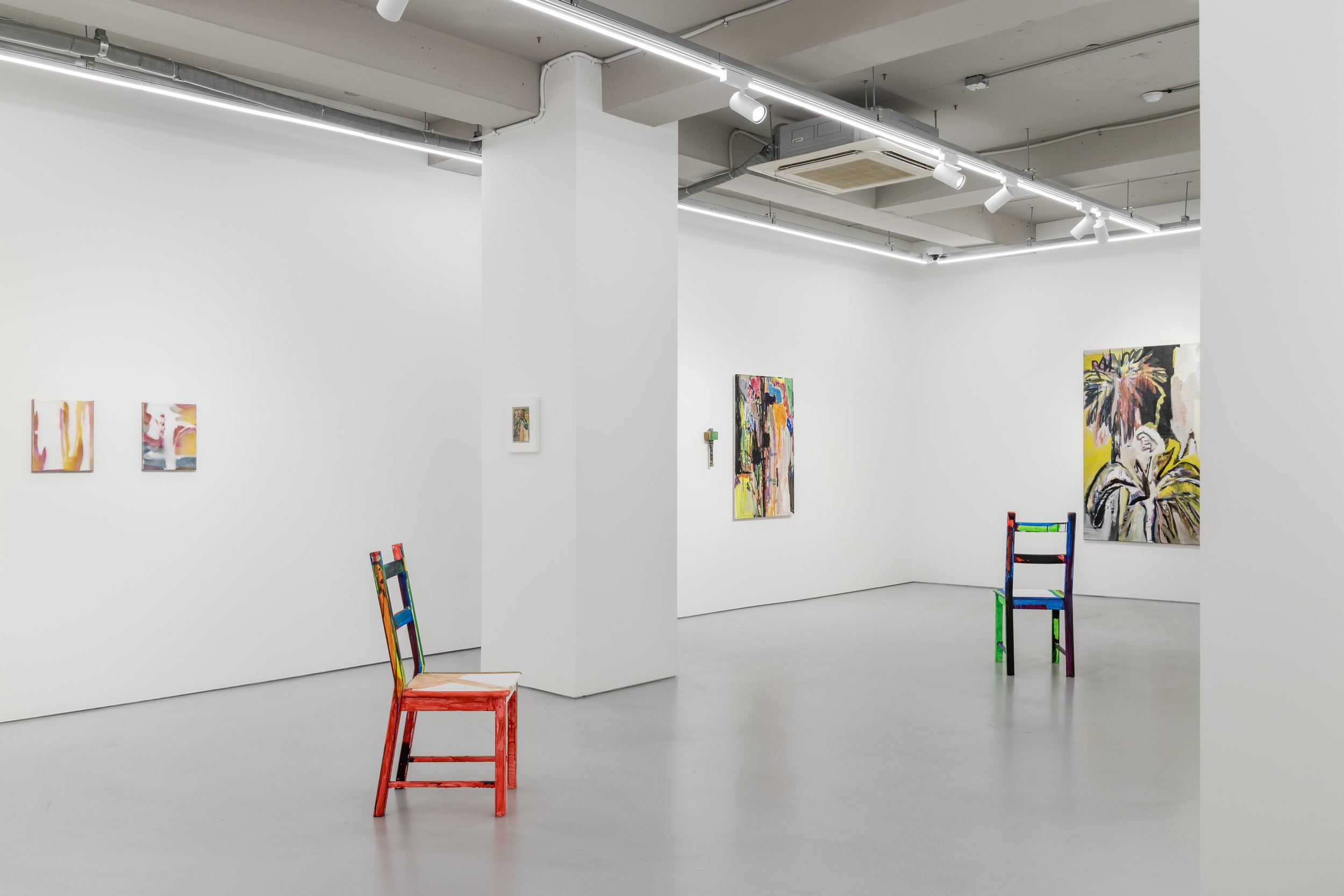
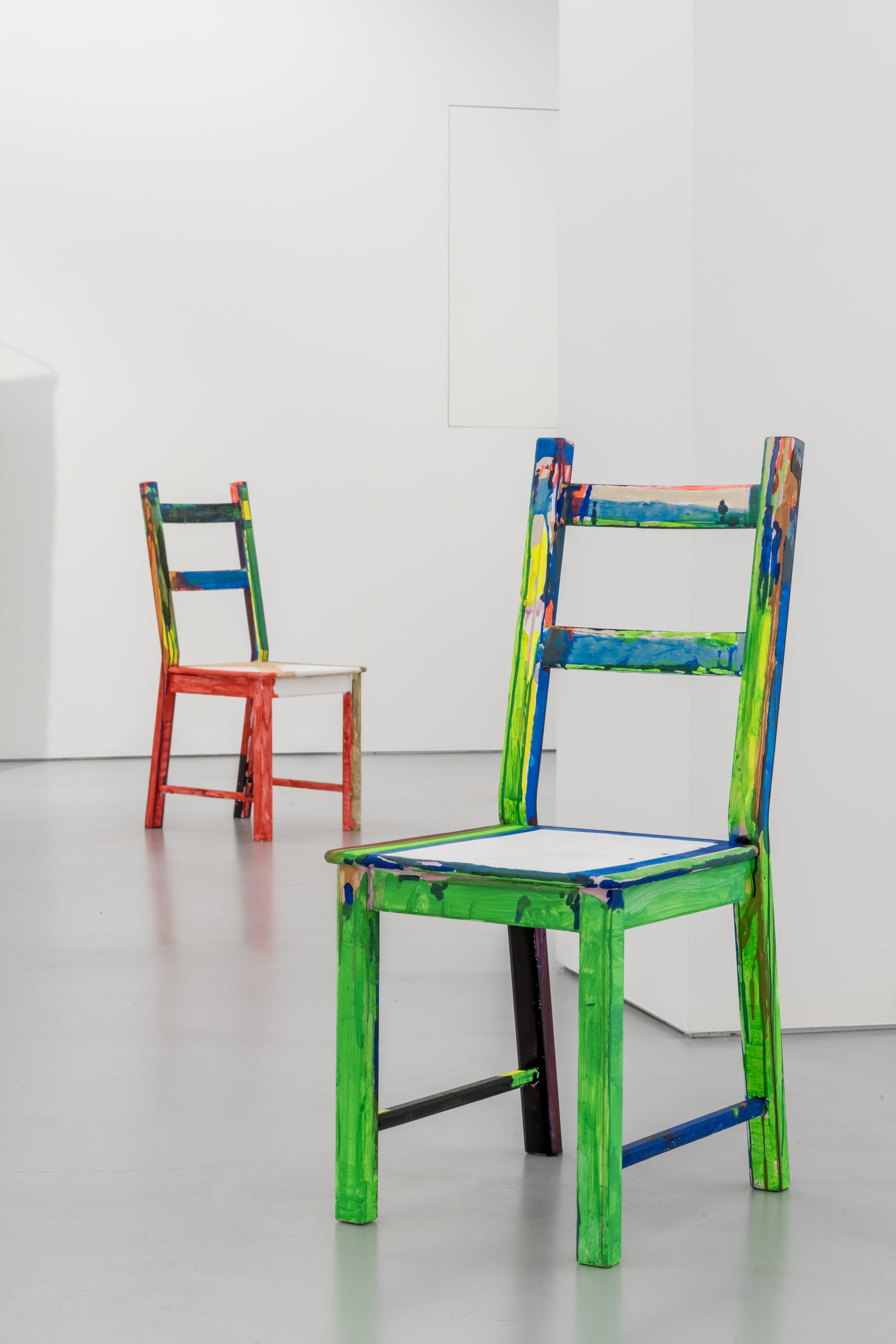
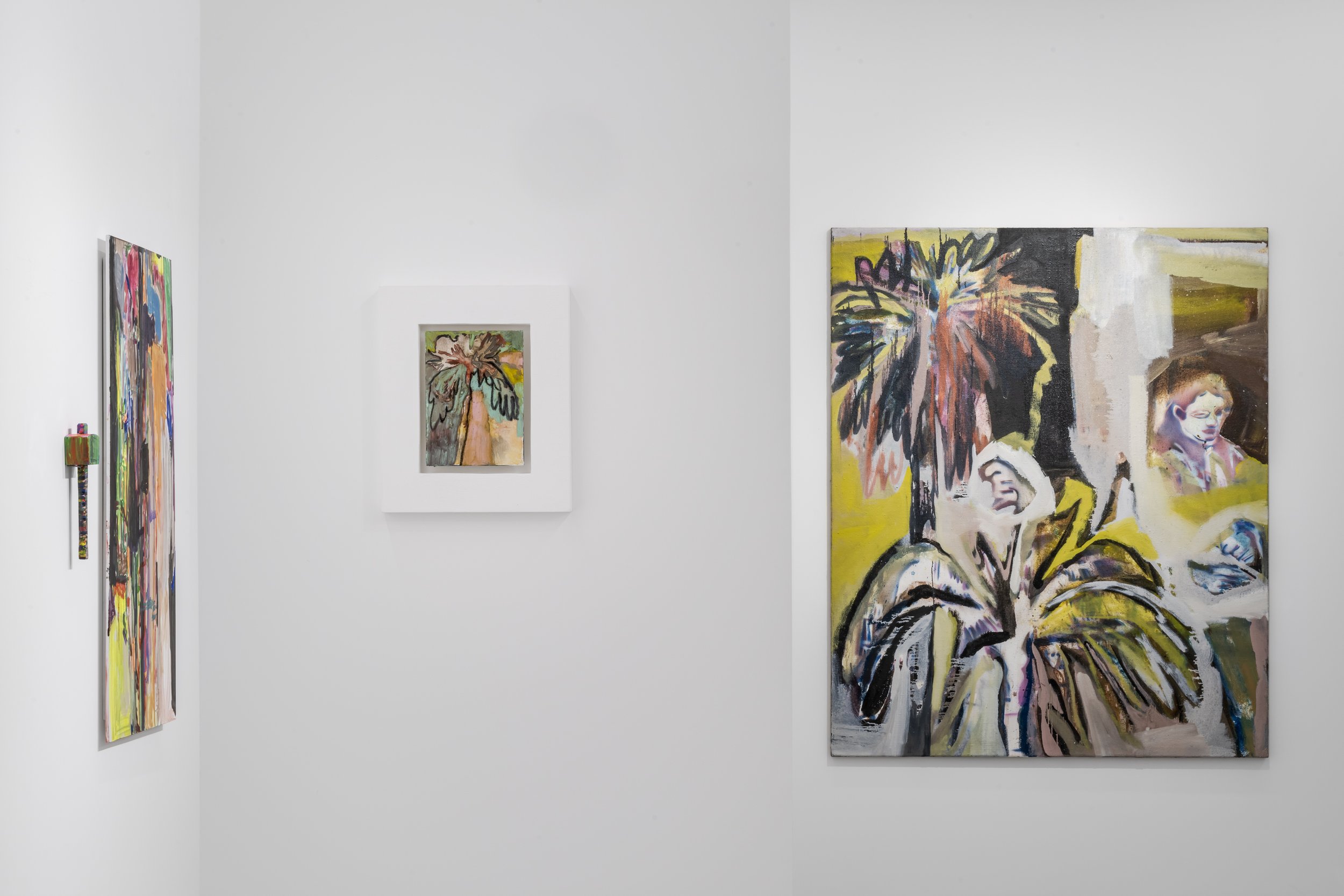

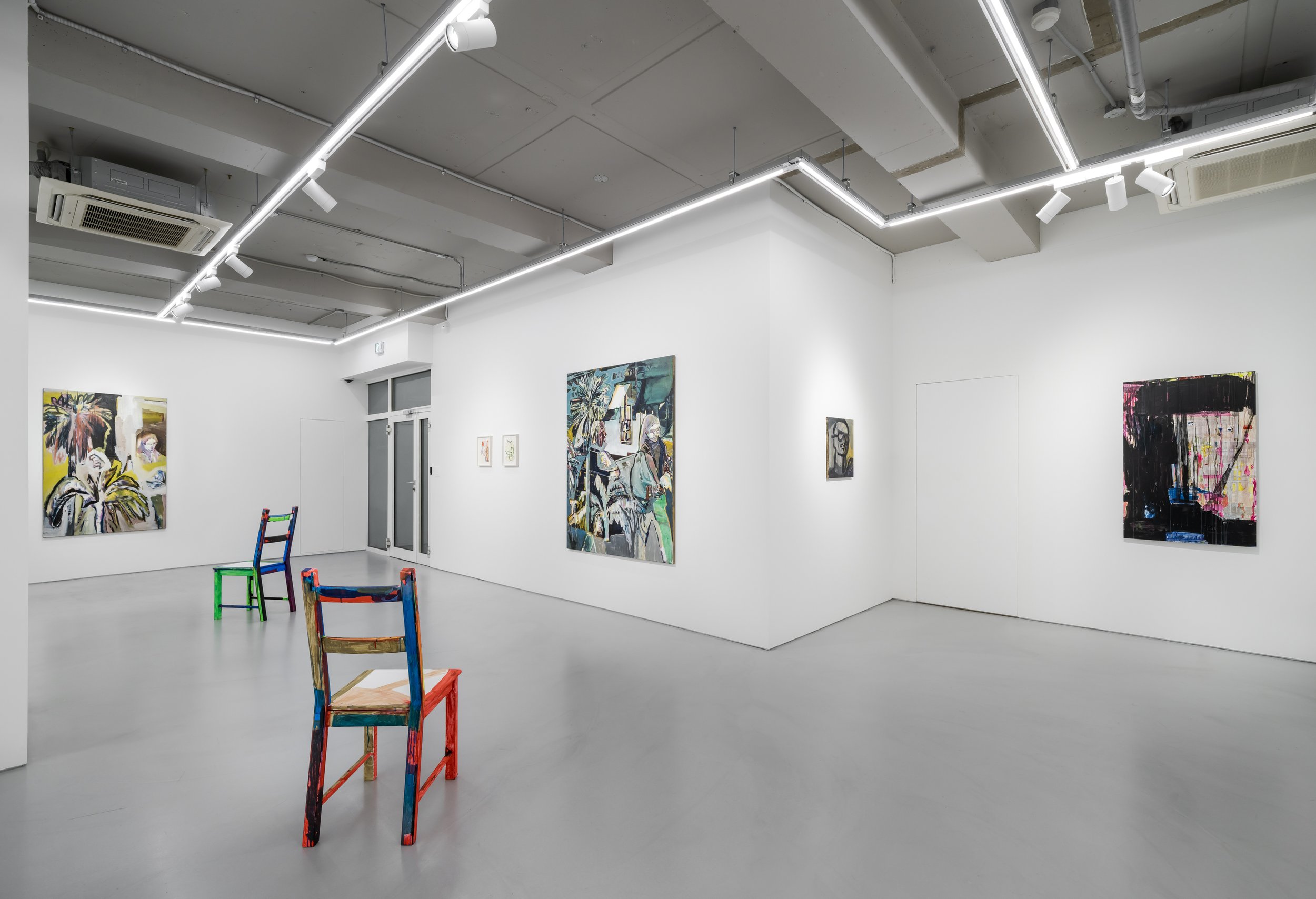



PRESS RELEASE
'Life Like Looking' at Efremedis, Seoul
04.08 — 30.08.2023
For Arthur Laidlaw and Hayley Tompkins, the act of looking is a shared fascination. In their works, a desire to ‘really see some- thing’ becomes entwined with desires for proximity and tactile immediacy. Looking is enacted through gestures of painting, tracing, coating and dissecting; thick layers of material and repeated details which can feel at once caring and obsessive, loving and smothering. The results are bright, dynamic abstractions and tangled perspec- tives – far flung from any objective visual reality. For these artists, after all, the goal of looking was never really to represent, rather an attempt to collapse the distance which separates artist from image.
–
All images courtesy of Efremidis & the artists

Wool, hessian, and latex glue
Installed with cable, wire clamps, pulley, carabiner, and manual winch
170 x 130 cm (dimensions variable)
2023

“Why fascination? Seeing presupposes distance, decisiveness which separates, the power to stay out of contact and in contact avoid confusion ... But what happens when what you see, although at a distance, seems to touch you with a gripping contact, when the manner of seeing is a kind of touch, when seeing is contact at a distance?”
– Maurice Blanchot
In The Space of Literature, French philos- opher Maurice Blanchot writes that the possibility of seeing is separation. Seeing is a register of distance. Fascination, he continues, is a kind of seeing which has got too close – a ‘grip- ping contact’ which paradoxically confuses and obscures the image.
For Arthur Laidlaw and Hayley Tompkins, the act of looking is a shared fascination. In their works, a desire to ‘really see some- thing’ becomes entwined with desires for proximity and tactile immediacy. Looking is enacted through gestures of painting, tracing, coating and dissecting; thick layers of material and repeated details which can feel at once caring and obsessive, loving and smothering. The results are bright, dynamic abstractions and tangled perspec- tives – far flung from any objective visual reality. For these artists, after all, the goal of looking was never really to represent, rather an attempt to collapse the distance which separates artist from image.
Arthur Laidlaw’s images are densely layered, their surfaces rich with colour and entan- gled perspectives. The artist’s practice is broadly concerned with the extant physical- ity of history, the residues left by the past on cities and architecture, but his paintings often attend to more intimate questions of personal memory and its fallibility.
Compositions and colour palettes are closely informed by the techniques and nuances of photography, and Laidlaw has suggested that his work could be seen as an attempt to capture something missed by the photo- graphic instant. He often begins by merg- ing two or more photographs in photoshop, which, after playing with transparency, inver- sion and contrast, he converts to greyscale, indexing each shade of grey to a paint colour for the final work.
This process results in a reshuffling of light and shade, positive and negative between the layered images, thus disorienting a percep- tion of space. Laidlaw’s colour choices are also informed by this digital inversion: livid violets and muddy ochres, bright empty whites where shadows should be.
From shapes and outlines in these initial edits, Laidlaw makes paper stencils which are used for an application of sprayed gouache which provides the foundational layer of his images. On top of the gouache, the artist builds layers of oil paint and pastel, sometimes tracing the background gouache, sometimes interrupting and contradicting it with loose, expressive strokes. The two large format paintings Fallow and Cut Glass each began this way with the same stencilled background, however further layers of paint and pastel took them in different directions. Still, the original shared composition echoes through, alluding to fragments of experi- ence and memory which can haunt future moments.
These meticulous processes of layering, editing, mapping and tracing of an image’s structural components could be read as an almost obsessive attempt to pry open some central truth. However, narrative clarity or pictorial coherence is always abandoned in favour of a rich, plural subjectivity, in which images are allowed to merge, oppose, echo and clash without conclusion.
The paintings and painted objects of Hayley Tompkins also deal in contradictions. Her painted wooden chairs and mallet merge the familiar intimacy of a functional object with the untouchable aura of ‘a work of art’. By coating these objects with paint, it’s as though the act of looking is replaced by the stroke of the brush. The artist’s gaze becomes identical with the tactile handling of the thing and the applications of paint which smother it. ‘Looking’ leaves a residue.
Tompkins begins by painting the chairs entirely white, denuding the object of its original associations before adding layers of colour. She will often work on several pieces in tandem, mixing one colour at a time and applying it to a number of different pieces before moving to a new shade. She describes this process as a ‘cross-pollination’ – an opportunity to ‘see what the colour is doing’, acknowledging colour as a multifaceted, active agency.
Long brushstrokes follow the chairs’ straight edges, as if tracing its form to make a draw- ing in space. This apparently simple appli- cation speaks to a particular intimacy of attention seen throughout Tompkins’ work, making visible the direct moment of contact between observer and observed object.
While she would usually apply colour all over the chairs, for this exhibition Tompkins has allowed white spaces to remain as a vague performative absence: an invitation, perhaps, for a body to be held within the painting.
Tompkins’ works on paper and panel paintings follow a similarly intuitive process, arising as records of change- able moods and shifting states of mind. Some compositions are densely filled with interlocking blocks of colour suggesting the solid forms of interiors, figures and land- scapes, while in others the mark-making is loose and brusque, like a quickly sketched diagram of some half-grasped relation. These streaks, floods and calligraphic tangles play- fully evade any resolution, expressing instead the pleasure of an unfolding, open-ended process, and reminding us that looking is itself a slippery, changeable act.
–
어째서 매혹(fascination)일까? 본다는 것은 보는 거리를, 분리의 결정을 전제로 이루어진 다. 거리를 두기 때문에 접촉도, 오해의 여지도 없다. 하지만 거리를 둔 오브제를 바라보며 무 엇인가가 와닿아 접촉되는 느낌이 있다면? 손 끝에 닿는 것이 아니라 손안에 붙잡히는 감각 이라면 어떠한가? 시각이 원격 접촉의 방식이 라면 바라봄 속에 어루만짐의 특징 또한 전달
되지 않는가? - 모리스 블랑쇼(Maurice Blanchot)
프랑스 철학자 모리스 블랑쇼는 1955년에 출 판한 『문학의 공간*L’Espace littéraire)』에서 ‘본다는 것’과 ‘거리감’의 관계를 탐구했다. 본 다는 것은 거리의 표명이다. 매혹이란 거리를 둔 보기가 아닌 근접한 보기로 인해 발생하며 이미지를 혼란스럽고 모호하게 흐리는 ‘정념적 사로잡힘’이라고 설명한다.
아서 레이들로(Arthur Laidlaw)와 헤일리 톰킨 스(Hayley Tompkins)는 바라봄(looking) 그 자체에 매혹되어 작품에 ‘대상을 진정으로 보 고 싶다’는 욕망과 피부에 닿을 듯한 밀접함 및 촉각적 당면성을 향한 욕망이 얽혀있다. 바라 봄은 두꺼운 재료의 겹층, 반복되는 디테일의 회화-추적-해부적 몸짓을 통해 이루어지는데, 배려와 집착, 친밀과 숨막힘의 느낌을 동시에 주기도 한다. 결과는 밝게 구성된 느슨한 추상 과 분산된 원근법이 주는 회화적 모호함이다. 이는 두 작가가 붓을 쥔 목적은 어떠한 객관적 인 시각적 현실을 구체화하기 위함이 아닌, 작 가와 이미지 사이의 거리를 상쇄하기 위한 ‘바 라봄’이기 때문이다.
아서 레이들로(Arthur Laidlaw)의 도상은 밀도 있는 레이어와 풍부한 색감, 그리고 복잡하게 얽힌 원근감으로 가득하게 구성되어있다. 그의 작업은 대체로 역사의 현존하는 물성, 즉 도시 와 건축물을 통해 남은 과거의 흔적에 주로 관 심을 두었다, 그러나 그의 페인팅은 종종 개인 적인 기억과 그것의 오류 가능성에 대한 보다 친밀한 질문에 주의를 기울입니다.
사진 기법과 구성 뉘앙스에 의한 그의 작업의 구성과 색상들은 사진이 놓친 무언가를 포착하 려는 회화의 시도라 제시한다.
작가는 포토샵을 사용하여 두 장 이상의 사진 을 병합한 뒤 투명도, 색상의 반전 및 대비 등 의 조정을 한 후 그레이스케일로 변환하여 각 회색의 단계별 음영마다 특정한 값을 지정하 여 덧칠하는 방식을 사용하는데, 이미지의 층 위 사이의 빛과 어둠, 음각과 양각을 재분배하 고 재구성하여 공간감을 와해하는 작가의 방식 이다. 검붉은 바이올렛색과 진창의 황토색 또 는 그림자가 있어야 할 곳을 차지하는 텅 빈 흰 색의 도치 등, 색상 선택도 이러한 디지털 반전 의 결과다.
작업 초반에 편집한 형태와 윤곽선을 바탕으로 종이 조각(스텐실)을 만들고 이미지의 기본 레 이어를 구성하는 구아슈(gouache) 스프레이 에 활용한다. 종이 조각들을 사용해 뿌린 구아 슈 위에 유화물감과 파스텔을 겹겹이 쌓아 올 리는 작가는 기본 레이어의 구아슈를 그대로 따 라 그리기도 하고 때로는 구아슈를 거스르는 붓질을더하기도한다.두폭의대형회화작품 인 〈Fallow(휴경지)〉와 〈Cut Glass(절면 유 리)〉는 동일한 종이조각 배경으로 만들었지만 물감과 파스텔을 칠하는 과정에서 다른 작품이 되었다. 공유된 배경은 공유된 경험과 기억의 파편처럼 울림이 있으며 미래에 다시 마주하게 될 순간을 암시한다.
이미지의 구조적 요소에 기울인 세심한 손길과 집중된 레이어링, 편집, 매핑, 투사(tracing) 작 업은 표면이 숨긴 심층적인 진리를 끌어내기 위 한 일종의 강박 같기도 하다. 작가는 서사의 명 료함이나 그림의 시각적 일관성은 매번 풍부한 다원적 주관성을 위해 포기된다. 결국 이미지는 결론 없이 합쳐지고, 대립되고, 울려 퍼지고, 충 돌할 수 있는 이미지의 주관성을 허용한다.
헤일리 톰킨스(Hayley Tompkins)의 그림과 회화적 오브제 역시 바라봄의 모순을 다룬다. 페인트칠이 된 나무 의자와 망치는 기능을 가 진 사물의 익숙함과 ‘예술 작품’이 가진 범접할 수 없는 아우라를 교차한다. 페인트가 도포된 의자와 망치를 바라보면 마치 바라봄이 붓질로 대체된 것만 같은 느낌을 받는다. 작가의 바라 봄과, 오브제의 촉각성, 페인트가 칠해짐이 중 첩된다. 바라봄이 남기는 흔적, 여운이다.
작가는 의자를 온전한 흰색으로 칠해 의자와 관련된 연상 작용을 제거한 후 새로운 색을 층 층이 입힌다. 하나의 페인트 색을 혼합하여 동 시에 제작하는 여러 작품에 사용하고 새로운 페인트 색을 혼합하여 이를 반복한다. 이것을 ‘ 교차 수분’이라 부르는 그녀는 색을 다면적이 고 능동적인 주체로 간주하여 ‘색이 무엇을 하 는지 볼 수 있는 기회’라 설명한다.
획이 긴 붓질로 칠한 의자의 곧은 가장자리 선 들은마치물체를추적하여공간에그림을그 리는 것 같다. 단순한 페인트칠이지만 ‘관심’의 환기가 얼마나 친밀한 것인지, 보는 자와 보이 는 것의 접점을 드러내 보인다. 톰킨스는 평소 의자 전체를 색으로 칠하지만, 이번에는 여백 을두어모호한부재,즉그림안에시선과함께 몸을 담을 수 있는 여유를 남겼다.
작가의 종이 작업은 유사한 맥락에서 직관을 쫓아 변화무쌍한 기분과 변화하는 마음 상태를 기록하여 드러낸다. 구성의 일부는 서로 맞물 린 색상 블록으로 촘촘하게 채워져 인테리어, 인물 및 풍경의 견고한 형태를 암시한다. 또 다 른 일부는 찰나의 관계를 빠르게 스케치한 도 표처럼 느슨하고 투박하게 표시한다. 이러한 색과 선은 종착점 없이 자유롭게 유희하고, 변 화하고 펼쳐지는 과정을 묘사하며 ‘바라봄’의 동태성과 아른거리는 습성에 안착한다.
–
All images courtesy of Efremidis & the artists